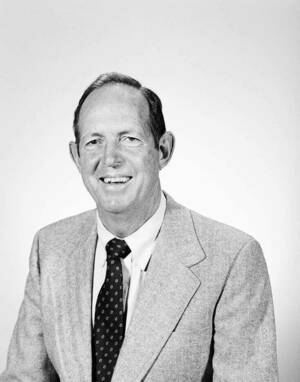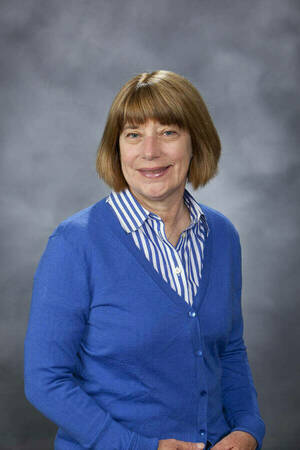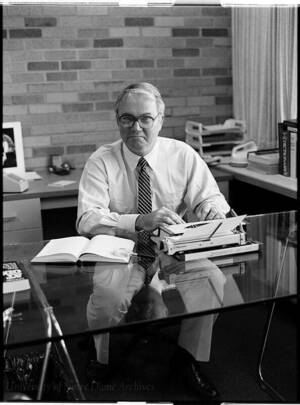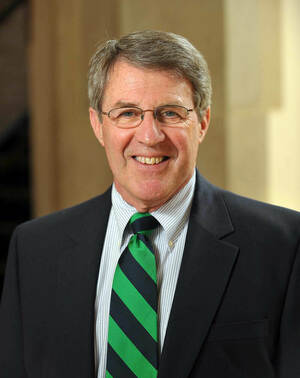
Luther M. Snavely Jr. was director of bands and a professor of music at Notre Dame from 1987 to ’99. Under his leadership, the Notre Dame Marching Band grew from 175 to more than 300 members, marched at 11 bowl games, moved into its current home, the Ricci Band Rehearsal Hall, and received more television exposure than any other marching band in the country.
A native of Texas and all-state horn player in his teens, Snavely would expand his craft at Baylor University, Vandercook College of Music and the University of Texas. He served in the U.S. Army and was assigned to the Fourth Army Band. He was director of bands at the University of Mississippi before coming to Notre Dame; at one point more than 150 of his proteges were teaching music and directing bands in every imaginable corner of the United States.
An avid golfer and traveler, Snavely loved the fall sport around which he and his student-musicians spent so much of their time and was regarded as something of a student of the game.
Snavely died October 25 at age 90. He is survived by his wife, Rebecca, son Luther III ’89, ’94J.D., and daughter Kelly ’95. The marching band formed his surname on the field during the October 30 Notre Dame-North Carolina home football game and played “Notre Dame, Our Mother” in his memory.

Frank K. Reilly ’57 returned to his alma mater in 1981 to lead the business school into a new era. He instituted innovative programs, including the accelerated one-year MBA degree, the Executive MBA and other executive development curricula that forged alliances between the business community and academia and exposed students to real-life situations they would encounter in their careers.
The Martin J. Gillen Dean Emeritus and Bernard J. Hank Professor Emeritus of Finance in the Mendoza College of Business “was a role model of servant-leadership,” said Rev. Oliver F. Williams, CSC, ’61, ’69M.Th., an associate professor of management and director of the University’s Center for Ethics and Religious Values in Business. “Frank always believed his role was to bring out the best in everybody, and he was good at that.”
Reilly was born in Chicago and completed his graduate work at Northwestern University and the University of Chicago. An expert in security analysis, capital markets, credit analysis and security market indexes, he taught courses in applied investment management, capital budgeting and fixed-income analysis and investments, among others.
Reilly had an amiable, easygoing personality and was a careful listener, the recipient of numerous honors, including the University’s Outstanding Teacher Award. He served as dean from 1981 to ’87 and taught until 2015. In retirement, he could often be found in his campus office continuing his reading and research. “For him, it wasn’t work. He loved it,” Williams says. “I always saw Frank as the type of role model we’d like for all our faculty.”
For years, Reilly hosted large St. Patrick’s Day gatherings for business faculty at his home, and as a hobby he collected business-related antiques. It was Reilly who in 1982 obtained a vintage New York Stock Exchange trading post that has been on display for many years in the central lobby of the Mendoza College of Business.
His wife, Therese, preceded him in death in 2015. Reilly died September 23 at age 85.

Her titles may have been “adjunct professor” and later “professional specialist,” but for 25 years Karen Heisler enriched the education of hundreds of students learning about television production and contemporary media. By melding her professional knowledge with personal enthusiasm, Heisler became a favorite teacher of those pursuing careers in communications as well as those following other paths.
Born in 1954 in Middletown, Ohio, Karen Croake Heisler earned her bachelor’s and master’s degrees from Purdue University. She was an ardent fan of Johnny Bench, Tony Perez and Cincinnati’s Big Red Machine and a loyal Boilermaker whose Notre Dame career began in the University’s sports information department. There she produced multiple media guides and game programs judged best in the nation. Even after leaving athletics, she lent her ample writing and editing talents to the department, serving as editor of its annual report and contributing to Notre Dame’s Strong of Heart book series. She was the author of Fighting Irish: Legends, Lists and Lore and a fastidious grammarian whose red pencil left extensive marks on student papers and colleagues’ prose.
Heisler joined the staff at WNDU-TV in 1984, serving as promotions manager and then program director. Over the years she received seven gold medallions from Broadcast Promotion and Marketing Executives, a professional organization, for her work on print ads, commercials, news campaigns and marketing materials. In 1993, she joined the Notre Dame faculty, teaching courses in broadcasting, TV sports and the industry’s business side. From there, Heisler was instrumental in developing courses and managing internships for the rapidly expanding program, thinking foremost about the students and their needs. A colleague described her as a person whose “whole goal was to make people better — better writers, better people, better thinkers.”
Her friendly ways, sense of humor and perpetually upbeat nature lifted the spirits of others, even as she dealt with bouts of cancer. Heisler died September 19 in Orlando, Florida. She is survived by her husband, John, a longtime associate director of athletics and sports information chief at Notre Dame, and two sons.

Asked once to identify the qualities one needed to be a historian, Walter T.K. Nugent replied with the laconic candor and oblique wit that a generation of Notre Dame undergraduate and graduate students would instantly recognize. “Empathy, openness to new and . . . seemingly irrelevant ideas and phenomena,” he wrote, adding “curiosity, skepticism, Sitzfleisch” — that last German word meaning endurance or, somewhat more literally, the power to sit on your rear end for long stretches of time.
The Andrew V. Tackes Professor Emeritus of History may have developed that last talent while supporting himself as a graduate student at the University of Chicago by playing the organ at the former St. Bride parish on the city’s south side. Having fallen in love with history in childhood, the native of Watertown, New York, studied the European past at Georgetown University before seeding his encyclopedic knowledge of America’s at Chicago. “Walter has, like, four brains,” an admiring graduate student once remarked, and Nugent’s heroic academic output — 13 masterful books and more than 200 articles and book reviews ranging across subjects from Kansas populism, monetary history and transatlantic migration to U.S. imperialism and the American West — proved the point.
Nugent knew just what to do with all he’d acquired: “Prolific and versatile” is how the Pulitzer Prize-winning Oxford historian Daniel Walker Howe once described him; “lucid” and “vivid” was Howe’s characterization of Nugent’s 2008 analysis of American expansionism, Habits of Empire.
During a teaching career that included 21 years at Indiana University and 16 at Notre Dame before his retirement in 2000, Nugent distinguished himself as a leading historian of immigration, demographics, U.S. politics and the Gilded Age and Progressive Era. With gentle grace he directed eight doctoral dissertations at Notre Dame; the award for the best graduate-student paper delivered at the annual conference of the Indiana Association of Historians is named for him.
Nugent, 86, died September 8 in Seattle. He is survived by his wife, Suellen Hoy, a Saint Mary’s College alumna who taught history at Notre Dame, and six children from a previous marriage.

In the 1980s and ’90s, Terrence Rettig regularly welcomed students and other guests for evening astronomy sessions at the observatory on the rooftop of Nieuwland Science Hall. Later, eager to share his fascination with the universe, he became a driving force behind the creation of the Digital Visualization Theater and the operations of the Sarah L. Krizmanich Telescope in the Jordan Hall of Science.
“I view him as the founder of astronomy at Notre Dame,” said Peter Garnavich, professor of physics and chair of the Department of Physics.
Rettig, who retired as a professor of astrophysics in 2020, died August 22. He was 74.
Born and raised in Defiance, Ohio, Rettig earned a bachelor’s degree at Defiance College, a master’s in physics from Ball State University and a doctorate in astrophysics from Indiana University. When he joined the Notre Dame faculty in 1983, the University didn’t have an astronomy group. Rettig began teaching introductory courses and gave the discipline a toehold. His research primarily focused on understanding the collapse of protoplanetary disks and the conditions under which planets form. As a program director, he helped to establish the National Science Foundation’s Research Experiences for Undergraduates program at Notre Dame — the longest-running REU program for physics in the country.
In 1985-86, Rettig was among a group of researchers from Notre Dame and Fermilab who drew international attention for their study of Halley’s Comet, which returns to Earth’s vicinity about every 75 years. The team reproduced images of the comet faster than any other; Rettig’s role required travel to a remote site in Australia to get the best view of the celestial iceball.
While conducting research at the Vatican telescope on Arizona’s Mount Graham in 1996, Rettig learned of plans to build a state-of-the-art telescope that would become one of the world’s most powerful. He persuaded the University to invest in the $120 million project, which greatly advanced its astrophysics program. In 2000, the International Astronomical Union named Asteroid Rettig, a five-mile-wide space rock floating in the belt between Mars and Jupiter, in honor of his contributions to the field.
At home, Rettig’s abiding interests included airplanes, gardening, antique-clock collecting and spending time with his wife, Shari, and three stepchildren.

Timothy Francis Welsh coached the men’s swimming team for three decades, leading both men’s and women’s swimming for 10 of those years. His teams won the Big East championship six times, earned the University’s first invitations to the NCAA Championship meet, garnered its first All-American honors, set multiple records and sent swimmers to the Olympic Games.
In 2014, the College Swimming Coaches Association of America (CSCAA) presented Welsh with its highest honor, the National Collegiate and Scholastic Swimming Trophy. But the most eloquent testimonial about the quality of his leadership may have been the former swimmers who visited their coach during the final leg in his battle with pancreatic cancer. Welsh died June 2 at age 76.
Born in Schenectady, New York, Welsh graduated from Providence College, earned a master’s degree in English from the University of Virginia and was on his way to a doctorate when life intervened — and he answered the call. He began coaching while attending Syracuse University, then took his first head coaching position at Johns Hopkins University before coming to Notre Dame in 1985. A nonswimmer himself, Welsh, who retired in 2014, is remembered by family as a revered coach with the soul of a college professor, an introvert who loved reading, literature and the people in his life. That included not only his wife, Jackie Haywood, and his two sons, Tim ’02 and John ’05, who did become college professors, but also the student-athletes who competed for him. As a coach, he motivated his swimmers to pursue personal excellence and encouraged a familial devotion to teammates. Rarely was that sense of family more apparent than in the wake of a fatal bus crash in 1992, when the women’s team was returning to campus from a meet.
In addition to the CSCAA’s highest honor, Welsh was also the recipient of its Richard E. Steadman Award in 1993, the Franklin Award in 2019, and the Distinguished Service Award for 35 years in college coaching. Notre Dame honored the coach with its Presidential Achievement Award in 2009 and its Jesse Harper Award in 2019. He is also remembered fondly by contemporaries who would see him on campus wearing his navy blue Notre Dame parka and signature cowboy hat, often with a clear plastic cover to protect it from the South Bend elements.